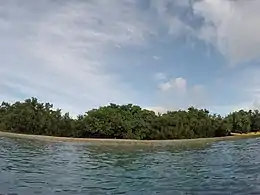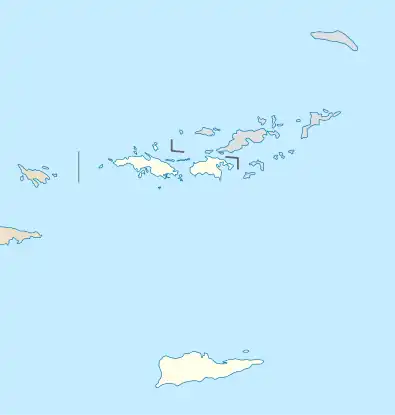 Cas Cay, 2014 | |
 Cas Cay Location in the Caribbean  Cas Cay Cas Cay (Caribbean) | |
| Geography | |
|---|---|
| Location | Caribbean Sea |
| Coordinates | 18°18′25″N 64°51′55″W / 18.30694°N 64.86528°W |
| Area | 50 acres (20 ha) |
| Administration | |
| Federal Department | U.S. Department of the Interior |
| Federal Agency | U.S. Fish and Wildlife Service |
| Capital city | Washington, D.C. |
| Largest settlement | New York City |
| President | Joseph Robinette Biden Jr. |
Cas Cay is a fifty-acre (200,000-square-metre) undeveloped island, situated a mile south of Red Hook on the eastern side of Saint Thomas in the United States Virgin Islands. It is under the protection of the Department of Natural Resources.[1][2] Ferries here depart from Compass Point Marina, right east of Nadir.[3]
Description
Cas Cay is a tropical island, which has a hundred feet tall hill with bird species such as the Red-billed- and White-tailed tropicbird. It is also home to endemic plant species such as orchids, Tabebuia, gumbo-limbos, as well as the seagrape, manchineel and numerous mangroves. It is home to lizards such as anoles, ameiva and geckos.[4] The island has a high density of rats (Rattus rattus) as well.[5] It has a mangrove lagoon and is one of the largest mangrove areas in the Virgin Islands.[6] Besides the mangrove ecosystem, the wildlife sanctuary, the natural whirlpool and blowhole, many visit the island for recreational activities such as snorkeling, scuba diving, kayaking and bird watching.[7] The nearby Cas Cay-Mangrove Lagoon Marine Reserve & Wildlife Sanctuary is located in the Jersey Bay immediately north of Cas Cay.
Important Bird Area
A 225 ha area, encompassing Cas Cay, neighbouring Bovoni and Patricia Cays, along with the Mangrove Lagoon marine reserve, has been recognised as an Important Bird Area (IBA) by BirdLife International because it supports populations of green-throated caribs, Antillean crested hummingbirds, pearly-eyed thrashers and Lesser Antillean bullfinches.[8]
References
- ↑ Sullivan, Lynne M. (2008). Adventure Guide Virgin Islands. Hunter Publishing, Inc. Page 84. ISBN 9781588435811.
- ↑ Colón, Christina Paulette (2011). Frommer's Caribbean. John Wiley & Sons. Page 26. ISBN 9781118107348.
- ↑ Greenberg, Harriet and Douglas (2006). The US Virgin Islands Alive!. Hunter Publishing, Inc. Page 68. ISBN 9781588435842.
- ↑ Nellis, David W. (2000). Puerto Rico & Virgin Islands Wildlife Viewing Guide. Falcon. Page 74. ISBN 9781560448365.
- ↑ Schwartz, Albert and Robert W. Henderson (1991). Amphibians and Reptiles of the West Indies: Descriptions, Distributions, and Natural History. University Press of Florida. Page 609. ISBN 9780813010496.
- ↑ Spalding, Mark (2010). World Atlas of Mangroves. Routledge. Page 198. ISBN 9781136530968.
- ↑ Showker, Kay and Mary Brennan (2008). Caribbean Ports of Call: Eastern and Southern Regions: A Guide for Today's Cruise Passengers. Globe Pequot. Page 73. ISBN 9780762745388.
- ↑ "Mangrove Lagoon". BirdLife Data Zone. BirdLife International. 2021. Retrieved 21 February 2021.